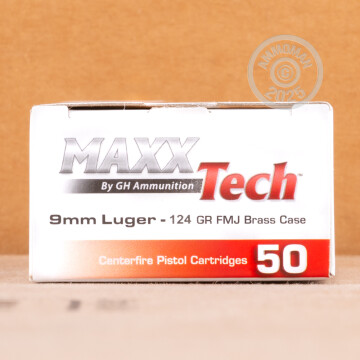Testing An AR-15 22 Conversion Kit
The AR-15 is one of America’s most-popular guns. The modular nature of the gun means that it can be adapted to a wide variety of purposes, from home defense to hunting to competition. An AR-15 can also be adapted to shoot a variety of different calibers. You know most of them. Calibers like 5.56mm/223, 300 Blackout, 224 Valkyrie and 6mm ARC. In addition to this, an AR pattern gun that shoots 223 or 5.56mm can shoot inexpensive 22LR ammunition by using an AR-15 22 conversion kit.
Why Use 22 LR In An AR-15?
At first glance, it makes no sense to shoot a rimfire round such as 22LR out of a gun designed for centerfire ammunition like 5.56mm or 223. Centerfire rounds use a shell casing with the primer. This sets off the gunpowder inside the cartridge, which located in the center of the rear of the cartridge. This is why they’re called “centerfire.” Rimfire rounds like 22 Long Rifle (aka 22LR) have their primers on the (you guessed it) rim of the shell casing.
Centerfire rounds tend to be more powerful. Rimfire rounds tend to be less expensive. Shooting less expensive ammunition with lower recoil starts to make a lot sense, especially if you’re introducing new shooters to the AR platform.
An AR-15 22 conversion kit changes how your AR-15 operates. A typical AR-15 is a semi-automatic rifle that uses a direct impingement system to cycle the action and feed a new round into the chamber. The expanding gases from the firing of each cartridge are siphoned off and sent back to the action of the gun. Those gases move the bolt of the gun to the rear, resetting the trigger and ejecting the spent casing. The movement of the bolt is slowed down and reversed by the spring in the buffer tube. The bolt then moves forward and loads a fresh round into the firing chamber. From there, the whole process is ready to start again.
How An AR-15 Conversion Kit Operates
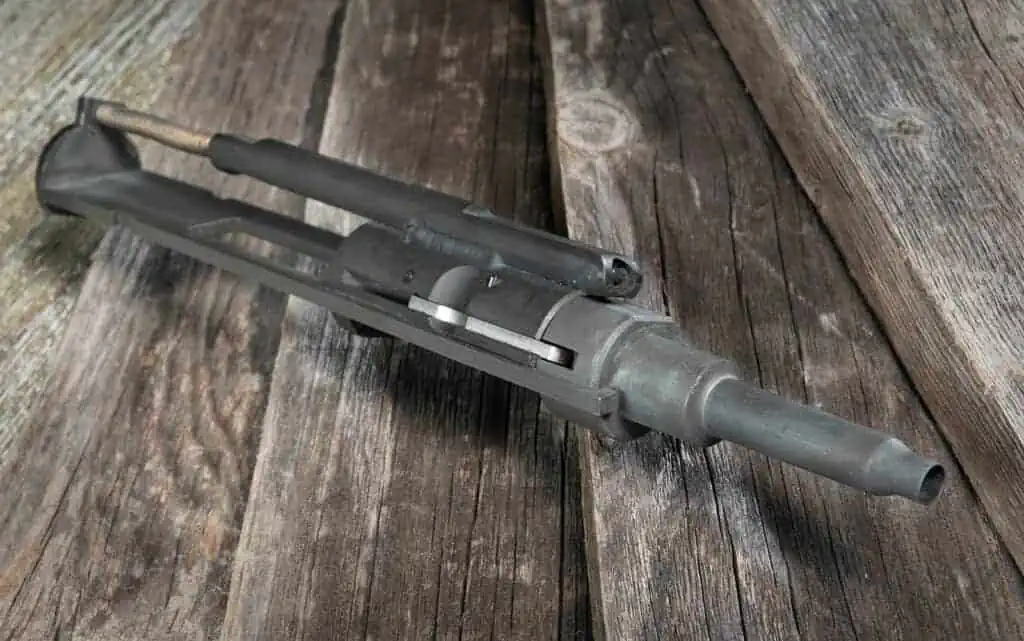 This process is different when you use a 22 conversion kit in your AR-15. The one we’re going to look at today is made by CMMG. It replaces your charging handle and 5.56mm bolt carrier group (BCG) with a drop-in rig that shoots 22LR. Installation of the kit is really easy. Just pop open the upper of your AR like you were removing the bolt carrier group for cleaning, and remove the BCG and charging handle. Replace the BCG with the 22 conversion kit and charging handle, close your rifle, and you’re good to go.
This process is different when you use a 22 conversion kit in your AR-15. The one we’re going to look at today is made by CMMG. It replaces your charging handle and 5.56mm bolt carrier group (BCG) with a drop-in rig that shoots 22LR. Installation of the kit is really easy. Just pop open the upper of your AR like you were removing the bolt carrier group for cleaning, and remove the BCG and charging handle. Replace the BCG with the 22 conversion kit and charging handle, close your rifle, and you’re good to go.
The CMMG AR-15 22 conversion kit operates in a different manner than a normal AR-15. It uses the force of the bullet firing to push the bolt to the rear, cycle the action and load a new round into the chamber. The gases from the round firing blow the bolt rearward. This is why we call this type of action a “blowback” action. According to CMMG, their conversion kit doesn’t use any of the gasses coming backwards through the gas tube. It is in fact compatible with some other AR-15 actions such as short stroke gas piston guns. In addition to this, the magazine for the CMMG kit has the same shape and feel as a 30 round AR magazine. Instead of holding 223/5.56mm ammo, though, it holds 25 rounds of 22 LR.
Let’s Take To The Range
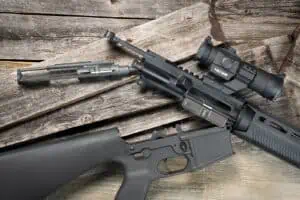 This is all well and good, but an AR-15 22 conversion kit needs to perform somewhat similar to a dedicated 22 rifle in order to be a useful tool, and not just a range toy. We swapped out the BCG inside of one of our AR-15s and brought it to the range, along with a Ruger 10/22. Both guns had 1x red dot optics on them. We shot from a rest at a target 50 yards away, and used a digital chronograph to measure the velocity of the rounds from each gun. We shot a five shot group using Federal Auto Match ammo, and compared the results using the Ammoman Shot Group Analyzer.
This is all well and good, but an AR-15 22 conversion kit needs to perform somewhat similar to a dedicated 22 rifle in order to be a useful tool, and not just a range toy. We swapped out the BCG inside of one of our AR-15s and brought it to the range, along with a Ruger 10/22. Both guns had 1x red dot optics on them. We shot from a rest at a target 50 yards away, and used a digital chronograph to measure the velocity of the rounds from each gun. We shot a five shot group using Federal Auto Match ammo, and compared the results using the Ammoman Shot Group Analyzer.
AR-15 22 Conversion Kit Results
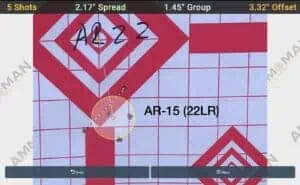 Average Group Size: 1.45 inches (2.9 MOA)
Average Group Size: 1.45 inches (2.9 MOA)
Average Muzzle Velocity: 1007 FPS
Shooting 22LR ammo from an AR-pattern gun is one of life’s great joys. You can practice the manual of arms for an AR-15, but at much lower cost. In addition to this, an AR shooting 22LR ammo is my favorite way to teach basic rifle skills to new gun owners. The 22 conversion kit produced acceptable but not outstanding results. 3(-ish) MOA is good for general plinking and learning how to run your gun. Of course, if you’re looking to do some hunting or precision rifle work, another gun might be a better option.
Ruger 10/22 Rifle Results
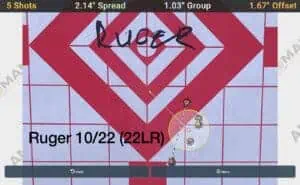 Average Group Size: 1.03 inches (2.06 MOA)
Average Group Size: 1.03 inches (2.06 MOA)
Average Muzzle Velocity: 1034 FPS
The Ruger 10/22 is an American icon, right up there with the AR-15. The magazine release on the 10/22 is a bit awkward, though, and everything you learn about running a 10/22 applies to just the 10/22, and not any other gun. It’s an accurate rifle, though, and outperformed the AR-15 22 conversion kit in our test.
Should You Buy An AR-15 22 Conversion Kit?
The answer to this question varies with each person. If you already have an AR-15, a 22 conversion kit is probably a good idea. They allow you to practice essential gun handling skills. You know, things like basic shooting positions and reloads at a greatly reduced ammunition cost. Also, as we said earlier, an AR in 22 is also a great way to teach others how to use an AR-15. If you already have a 22 LR rifle, a 22 conversion kit gives you another option when it’s time to go to the range.
However, if you don’t already own a 22 LR, it’s probably best to start out with a dedicated gun like the Ruger 10/22, Marlin 60, or even an AR-pattern gun that’s built in .22LR like the S&W M&P15-22. These can provide you with all the fun of shooting 22 LR and still have the accuracy you need to also go hunting, shoot a competition or take some training.
When it gets right down to it, an AR-15 22 conversion kit doesn’t replace your 223/5.56mm AR or your dedicated 22 rifle. Rather, it allows you to bring those two worlds together. You then can enjoy the feeling of shooting an AR-15, but with the lower cost and lower recoil of the 22 LR round.


